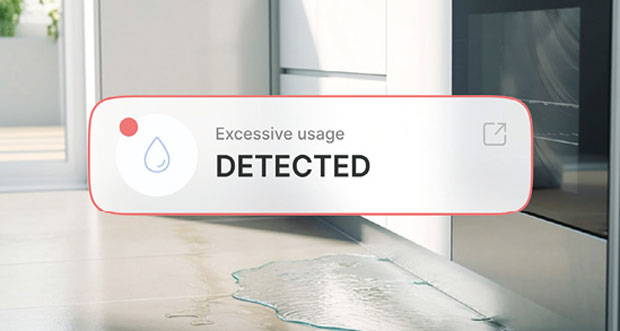 Krystian Zajac, Founder and CEO of Watergate, explains why smart stopcocks and other advanced technologies are a revolutionary way to combat water waste
Krystian Zajac, Founder and CEO of Watergate, explains why smart stopcocks and other advanced technologies are a revolutionary way to combat water waste
Water is one of our planet’s most precious resources, yet every day in Britain, we lose three billion litres to leaks – enough to fill 1,180 Olympic swimming pools.
Beyond the environmental impact, this wastage leads to substantial economic costs, with insurers paying out £16 million daily for water damage in UK properties. Water waste leads to inflated utility bills, equipment damage and repair costs. Not to mention organisational disruption and higher insurance premiums. With most organisations trying to become more sustainable, FMs are often charged with reporting on ESG metrics, including water usage.
There are numerous challenges in managing water effectively. Outdated plumbing systems, difficult-to-detect leaks, and tenant behaviour are all contributors. Retrofitting pipes is often costly and disruptive, and large facilities present unique challenges in leak detection and maintenance.
TECHNOLOGICAL INNOVATIONS
At Watergate, we strongly believe that technological innovation plays a crucial role in overcoming these obstacles. Beyond traditional methods, emerging technologies offer new ways to monitor and manage water use. Smart stopcocks for instance, provide real-time data and automated controls that are revolutionising water management.
Installed after the main stopcock, smart water shut-off valves use ultrasonic flow meters, pressure and temperature sensors to monitor water flow continuously. Leveraging artificial intelligence, these devices analyse usage patterns and can detect anomalies indicative of leaks or health risks (e.g. an elevated risk of Legionella), notifying managers through a companion app and even shutting off water to prevent damage.
In some of the properties where we are deployed, we’ve found that up to 10 per cent have pre-existing leaks. Leaky toilets are a particularly prevalent issue, with some wasting upwards of 1,500 litres of water a day. If we take the example of a student accommodation building with 600 rooms, this can translate to a staggering 2,700,000 (yes – 2.7m) litres of water a month wasted due to leaky toilets.
But smart stopcocks are just one piece of the puzzle. A range of other technologies can contribute to a more sustainable water management strategy.
Preventative Maintenance: Predictive analytics leveraging AI are transforming water management by enabling you to predict and prevent water waste before it happens. Predictive analytics use historical data and machine learning algorithms to identify patterns and predict future water usage and potential problems like appliances’ mechanical failures. This allows for proactive maintenance and repairs, reducing downtime and preventing water damage.
IoT (Internet of Things) Water Sensors: IoT-enabled water sensors can be placed throughout a facility to monitor water use in real-time, including flow rates, temperature, air humidity, and water quality. These sensors provide a comprehensive overview, alerting managers to any issues promptly.
An exciting advancement in this space are small, versatile leak detection sensors. These devices can detect leaks from appliances, waste pipes, and tanks, alerting to issues to prevent costly damage. Equipped with temperature and humidity sensors, they can also identify risks of dampness, which, if unaddressed, can lead to mould growth.
Many sensors run on long-lasting batteries, making them ideal for areas without mains power. They often use long-range radio technology, ensuring they function even where Wi-Fi is unavailable. One of Watergate’s upcoming products, Tile, is already being trialled at multiple sites to combat localised leaks and alert users to dampness risks.
Blockchain for Water Management: Although still in its early stages, blockchain technology holds promise for enhancing transparency and accountability in water management. By creating a secure, immutable record of water usage and transactions, blockchain can help ensure accurate reporting and reduce the risk of fraud. This is particularly useful for facilities that need to comply with stringent regulatory requirements and demonstrate their commitment to sustainability.
Smart Irrigation Systems: For facilities with significant landscaping needs, smart irrigation systems offer a way to reduce water waste and ensure optimal plant health. These systems use sensors and weather data to adjust watering schedules based on real-time conditions, preventing overwatering and ensuring that plants receive the right amount of water. This not only conserves water but also promotes healthier, more resilient landscapes.
The integration of these advanced technologies not only reduces the risk of water damage and associated insurance claims but also supports broader sustainability goals. Monitoring for water health risks, such as Legionella and dampness, is especially critical in high-risk environments like healthcare facilities, hotels, and social housing. By ensuring optimal water conditions, these systems protect both property and public health.
One of the most significant benefits of adopting these technologies is the ability to analyse and manage water usage across a portfolio of properties.
Facilities managers can leverage this data to develop targeted conservation strategies, optimise water consumption, and achieve significant cost savings. Furthermore, this data supports ESG reporting, helping organisations meet sustainability goals and comply with regulatory requirements.
The future of water management lies in the widespread adoption of these innovations. By better controlling water use and preventing leaks, we can protect our precious water resources and ensure the longevity of our buildings and the invaluable contents they house.





